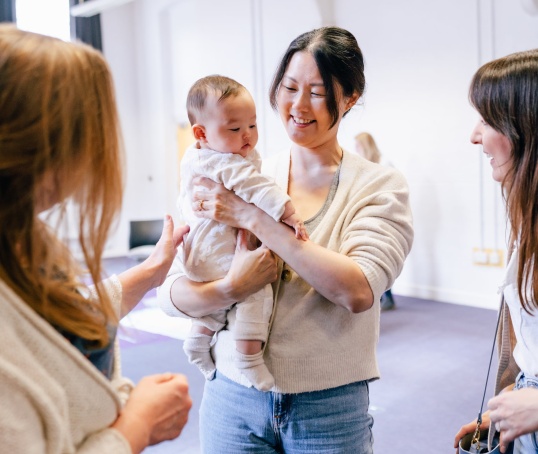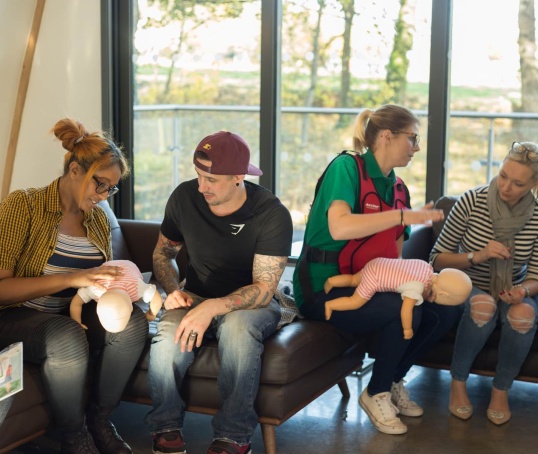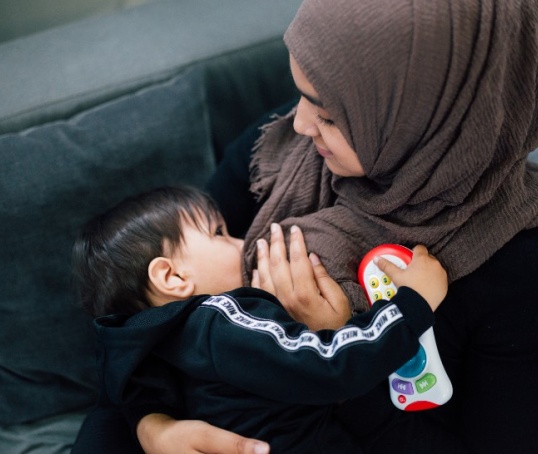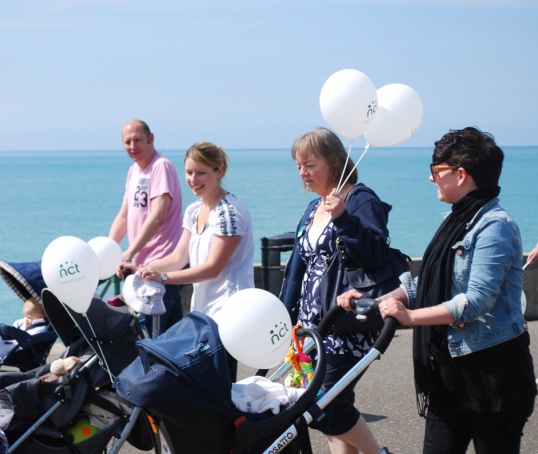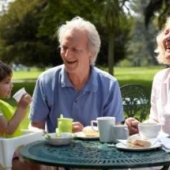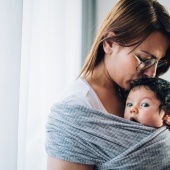It’s possible to enjoy the sun with a newborn or baby, but before heading out there are a few things to be aware of. Read our hot weather guide.
Can babies go out outside in hot weather?
Going for a walk or spending time outside, especially in nature, is good for a parent’s mental health. It can also help babies get used to the difference between day and night.
Just remember that babies and young children are more sensitive to the sun than adults, and extra care should be taken (NHS, 2022a).
Newborn sun safety
Under the age of six months, babies shouldn’t be exposed to direct sunlight (NHS, 2024).
Do (NHS, 2024a):
- keep young babies in the shade
- dress them in lightweight clothing
- shade the buggy with a parasol
- if using a sling, the baby needs a broad brimmed hat
Don’t (NHS, 2024a):
- use a blanket or muslin to cover the buggy as it can make it too hot underneath
- put sunscreen on a baby under six months, instead just keep them in the shade
Sunscreen and sun safety over 6 months
Being in strong sunlight frequently could lead to skin cancer in the future (NHS, 2022a). All skin tones are at risk of sunburn and skin cancer. Those with fair or red hair and pale white or light brown skin are most at risk (NHS, 2022a).
When babies are over six months, they can wear sunscreen. Remember to (NHS, 2024a):
- use sunscreen with a sun protection factor (SPF) of at least 50
- make sure it protects against both UVA and UVB rays
- opt for a brand specifically for babies and young children, as these are less likely to contain additives which might irritate skin
- reapply at least every two hours, and after swimming or sweating a lot
Even if wearing sunscreen, it’s still important to (NHS, 2024a; NHS, 2022a):
- dress them in lightweight clothing
- keep them out of the direct sun as much as possible, especially during the hottest part of the day between 11am and 3pm
- use a sunhat to protect their head and neck
- use sunglasses to protect their eyes, marked with the CE or BS standards
- use a parasol on the buggy, rather than covering with a muslin or blanket
- check on them regularly to make sure they’re not getting too hot
Treating sunburn
If skin does get sunburnt (NHS, 2022a):
- sponge with cool water
- apply a soothing aftersun lotion or spray, such as aloe vera
- stay out of the sun until the redness has gone
- infant paracetamol or ibuprofen can be taken to ease pain
Seek medical help if the baby seems unwell, or the skin swells or blisters (NHS, 2022a).
Keeping a baby hydrated
It’s especially important that babies have plenty of drinks in hot weather (NHS, 2024a). We also have an article on watching out for dehydration in babies.
Newborn babies
- Breastfed babies who aren’t yet eating solid food don’t need water to drink, but might want to breastfeed more often.
- Babies who only have formula milk can be offered small amounts of cooled boiled water, as well as their usual milk feeds.
Babies over six months old
- Once babies start having solid food, they can have water in a beaker or cup.
- Breastmilk or formula milk should still be their main drink.
- When a baby has started on solid food you can include water-rich foods like cucumber or watermelon.
Read more information in our article about when babies can have water to drink.
What is heat rash (prickly heat)?
Heat rash shows up a few days after sweat glands getting blocked (NHS, 2024b).
Heat rash can appear anywhere on the body, and can cause (NHS, 2024b):
- small, raised spots
- an itchy, prickly feeling
- swelling
- redness on white skin, or can appear grey or white on Black or Brown skin
It won’t usually do any harm and should go away after a few days. If it doesn’t or you’re worried, you can check with a GP (NHS, 2024b).
In the meantime, avoid irritating the rash by keeping the skin cool (NHS, 2024b):
- cool skin with a cool, damp cloth
- pat rather than scratch or rub the skin
- avoid using fragranced soaps or lotions
A pharmacist might suggest a soothing lotion or antihistamines if the rash is uncomfortable (NHS, 2024b). Prevent heat rash by keeping the baby cool.
Tips to keep a baby cool
General tips (NHS, 2024a; NHS, 2022b; Gov.uk, 2024):
- offer frequent drinks, especially if the baby is active
- dress babies in light, loose clothing, or even just a nappy
- try a bath with cool water before bedtime
- if carrying them in a sling, use one with lightweight fabric and remember the baby is receiving your body heat as well
- there may be local public places which are cooler than home – consider the library, an indoor shopping centre, or a shady park.
When babies are outside:
- keep them out of the direct sun between 11am and 3pm
- cool them down in a paddling or swimming pool, always with an adult supervising
- never leave a baby in a parked car, as it can get hot very quickly
At home:
- use a thermometer to check the baby’s room is between 16 and 20 degrees
- keep windows open at night if it is safe to do so
- close windows and blinds or curtains to prevent the room heating up during the day
- if it’s safe, keep doors open to help the air move
- use a fan to move the air, but don’t aim it at the baby as this could dehydrate them quicker
- turn off electrical equipment and lights that could add to the room heat
Heat exhaustion and heatstroke
If a baby gets too hot in the sun, it might cause heat exhaustion. Babies and children are more at risk of heat exhaustion or heat stroke (NHS, 2022b).
A baby might have heat exhaustion if they (NHS, 2022b):
- seem tired or dizzy
- are being sick
- are sweating a lot
- have pale and clammy skin, which can be harder to see on Black or Brown skin
- have a heat rash
- have a high temperature
- seem very thirsty
- are breathing fast
- have a fast heartbeat
- seem irritable
If this happens, take the baby to a shady or cool place out of the sun and give them drinks. Remove extra layers and spray or sponge them with cool water if possible (NHS, 2022b).
When the baby can be cooled down within 30 minutes, they don’t need medical help. If you’re unsure or want advice, you can call 111 (NHS, 2022b).
Heat stroke happens when someone can’t cool down. In this case, they might (NHS, 2022b):
- still seem unwell even after 30 minutes of being cooled
- have a very high temperature
- have hot skin that’s not sweating
- appear red (this can be harder to see on Black or Brown skin)
- have a fast heartbeat
- be breathing fast, or seem short of breath
- seem confused
- have a fit or seizure
- lose consciousness
Get immediate medical help for heatstroke by going to the Emergency Department or calling 999 (NHS, 2022b).
Should we get an air conditioner?
Some parents consider buying an air conditioning unit to keep the baby’s room cool. Bear in mind that these units remove moisture from the air, and because air conditioning reduces sweating it can mean we don’t feel thirsty, even when dehydrated.
So, if you decide to use one:
- keep offering fluids
- keep the settings on fan-only, to move the air
- if using the cooling function, set a temperature just lower than the room, rather than very cool (this reduces the amount of water removed from the air)
- take breaks by using it little and often, rather than constantly
- turn it off at night if the windows can be opened
- maintain the room humidity with a humidifier or damp towel
Gov.uk (2024) Beat the heat: Keep cool at home checklist. https://www.gov.uk/government/publications/beat-the-heat-hot-weather-ad… [18 Jun 25]
NHS (2022a) Sunscreen and sun safety. https://www.nhs.uk/live-well/seasonal-health/sunscreen-and-sun-safety/ [28 May 25]
NHS (2022b) Heat exhaustion and heatstroke. https://www.nhs.uk/conditions/heat-exhaustion-heatstroke/ [28 May 25]
NHS (2024a) Keeping your baby safe in the sun. https://www.nhs.uk/baby/first-aid-and-safety/safety/safety-in-the-sun/ [28 May 25]
NHS (2024b) Heat rash (prickly heat). https://www.nhs.uk/conditions/heat-rash-prickly-heat/ [28 May 25]


